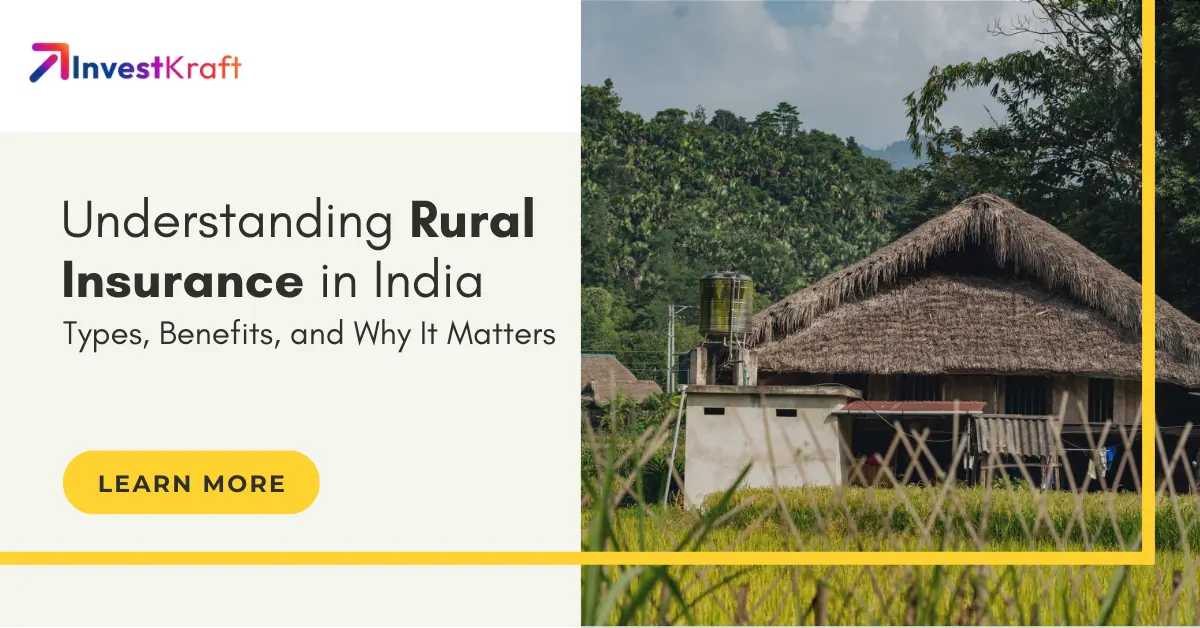Comprehensive Guide to Rural Insurance in India: Types, Features & Benefits

India is a nation where a significant portion of the population resides in rural areas. These communities are the backbone of our agricultural industry and play an important role in ensuring our nation's food security. However, rural life also comes with its own set of challenges. Their livelihoods are essentially linked to the environment, making them especially vulnerable to unforeseen circumstances like natural disasters, crop failure, or livestock illnesses resulting in financial instability. Rural insurance here acts as a useful and powerful source that aims to protect their well-being and save them from falling into the debt trap.
In this blog post, we have briefly discussed Rural Insurance in India, the role of technology, Types, Features, Advantages, Initiatives, Challenges, and other information that can help enhance your knowledge. Read it carefully to make informed decisions.
What is Rural Insurance?
Rural insurance is a specific insurance category designed to cater to the unique needs of the rural population in India. These plans offer financial protection against various unforeseen events that can disrupt the lives and livelihoods of people residing in rural areas.
What are the Different Types of Rural Insurance?
Rural insurance includes a variety of plans designed to address different risks the rural population faces. Here's a breakdown of some common types of rural insurance:
- Crop Insurance: This insurance protects farmers against financial losses due to natural calamities, pest attacks, and other unforeseen events that can damage or destroy crops.
- Weather Insurance: This type of insurance safeguards farmers against financial losses arising from adverse weather conditions like excessive rainfall, drought, or unseasonal frost.
- Cattle Insurance: This insurance policy provides financial compensation for the loss of cattle due to illness, disease, accident, or theft.
- Poultry Insurance: Similar to cattle insurance, this plan covers financial losses due to the death or illness of poultry birds.
- Farm Property Insurance: This insurance protects farm buildings, equipment, and other agricultural assets against damage caused by fire, theft, or natural disasters.
- Rural Personal Accident Insurance: This plan provides financial assistance to the insured person or their family members in case of accidental death, disability, or hospitalization due to an accident.
- Rural Health Insurance: This insurance helps cover medical expenses incurred due to hospitalization, surgeries, and other medical treatments.
Why is Rural Insurance Important?
Rural communities are particularly vulnerable to various risks. Here's a closer look at why rural insurance is essential:
- Income Instability: A large portion of rural income depends on agriculture and allied activities. These sectors are heavily influenced by factors beyond human control, such as weather patterns, pest attacks, and market fluctuations. Rural insurance helps mitigate the financial impact of such uncertainties by providing financial compensation for crop losses, livestock deaths, or other insured events.
- Natural Calamities: Rural areas are more prone to natural disasters like floods, droughts, and earthquakes. These events can cause widespread damage to property, crops, and livestock. Rural insurance plans can provide financial assistance to rebuild homes, replace lost crops or livestock, and get back on one's feet after a natural calamity.
- Health Risks: Access to quality healthcare facilities is often limited in rural areas. Medical emergencies can impose a significant financial burden on families. Rural insurance plans that include health insurance components can help cover medical expenses, and hospitalization costs, and even offer cashless treatment facilities at designated hospitals.
- Life Security: The untimely death of the primary earning member in a rural family can have devastating consequences. Life insurance plans included in rural insurance packages can provide a lump sum payout to the family in case of the insured person's demise. This financial assistance can help dependents tide over difficult times and meet essential needs.
- Accidents and Health Issues: Accidents and illnesses are unforeseen events that can disrupt income generation and impose a financial burden on rural families. Personal accident insurance and health insurance plans specifically designed for rural populations offer financial support during such times.
- Loss of Property and Assets: Theft, fire, or other unforeseen events can damage homes, agricultural equipment, or other valuable assets in rural areas. Property insurance plans provide financial compensation to help replace or repair damaged property.
More on the Advantages of Rural Insurance
Enhanced Investment and Growth: Financial security provided by insurance encourages rural families to save and invest in their farms and businesses. This fosters economic growth and development in rural areas.
- Social Upliftment: By mitigating financial risks associated with healthcare, rural insurance plans encourage timely medical care for families. This leads to better health outcomes and improves the overall well-being of rural communities.
- Empowering Women: Rural women often play a vital role in agriculture and allied activities. Insurance plans designed for women can provide them with financial independence and security, promoting gender equality in rural communities.
- Peace of Mind: Knowing that they have financial protection in place allows rural families to face challenges with greater peace of mind. They can focus on rebuilding their lives and livelihoods after a setback without the added burden of financial worry.
Key Features of Rural Insurance:
Customized Products: Rural insurance products are designed to address specific risks faced by rural households, such as crop failure, livestock loss, or damage to rural property.
- Affordable Premiums: Recognizing the limited financial resources of rural communities, insurers offer policies with low and affordable premiums.
- Simplified Processes: Rural insurance policies often feature simplified documentation and claim procedures to encourage widespread adoption.
- Government Support: Many rural insurance schemes are backed by government subsidies or initiatives, making them more accessible to the masses.
About The Rural Insurance in India: Schemes and Initiatives
The Indian government, recognizing the importance of rural insurance, has launched several initiatives to enhance insurance penetration in rural areas. Here's a look at some of the key schemes:
- Pradhan Mantri Fasal Bima Yojana (PMFBY): This flagship scheme provides subsidized crop insurance to farmers against crop losses arising from natural calamities, pests, and diseases.
- Pradhan Mantri Jeevan Jyoti Bima Yojana (PMJJBY) and Pradhan Mantri Suraksha Bima Yojana (PMSBY): These social security schemes offer affordable life and accident insurance covers to rural families.
- Rashtriya Krishi Vikas Yojana (RKVY): This scheme promotes various agricultural development initiatives, including the implementation of rural insurance schemes.
- Livestock Insurance Schemes: The government, in collaboration with insurance companies, offers various livestock insurance plans to protect farmers against financial losses due to the death or illness of their livestock.
These schemes, along with private insurance companies' offerings, are gradually creating a robust rural insurance ecosystem in India.
EXAMPLE RELATED TO RURAL INSURANCE
Let us understand the importance of rural insurance with the help of an example or scenario.
Below is an example of an incident in an Indian village where a farmer engaged in animal husbandry and crop cultivation incurs loss and receives compensation under rural insurance benefits:
The Incident
In a small village surrounded by green fields in Madhya Pradesh, lived Kapil Singh, a hardworking farmer. His family had been farming the land for many years, their lives closely connected to the changing seasons. To earn more money, Ram Singh also raised a small group of goats.
One year, during the rainy season, there was a very heavy flood. The rain didn't stop, and the water rose very high, covering Ram Singh's fields and ruining his entire wheat crop. The flood also destroyed the place where he kept his goats, and many of his goats sadly drowned.
Ram Singh was very worried about his family because of this double loss. Losing his crops and goats meant he would have much less money, making it difficult for him to pay back his debts and provide for his family's needs.
The Intervention
Fortunately, Ram Singh had the foresight to enroll in the Pradhan Mantri Fasal Bima Yojana (PMFBY), a government-sponsored crop insurance scheme. He had also opted for the Livestock Insurance Scheme offered by the National Insurance Company.
When the disaster struck, Ram Singh promptly informed the local insurance agent about the losses he had incurred. The insurance officials, after conducting a thorough assessment of the damage, processed his claims.
The Result
Within a few weeks, Ram Singh received compensation under both the PMFBY and the Livestock Insurance Scheme. The timely financial assistance provided a much-needed lifeline. He utilized the compensation to repay his loans, purchase seeds for the next cropping season, and rebuild his goat shed.
This experience reinforced Ram Singh's belief in the importance of insurance coverage for rural livelihoods. He became an advocate for these schemes within his community, encouraging fellow farmers to avail themselves of this crucial safety net.
Note: The above example reflects the challenges faced by rural farmers in India and the key role played by insurance schemes in minimizing their financial risks.
What are the Challenges in the Adoption of Rural Insurance?
Despite its benefits, rural insurance faces several challenges:
- Lack of Awareness: Many rural individuals are unaware of the existence or benefits of insurance products, leading to low penetration rates.
- Limited Access to Insurance Services: Geographical barriers and the lack of insurance providers in remote areas hinder the accessibility of rural insurance.
- Low Literacy Levels: Low literacy rates in rural areas make it difficult for individuals to understand insurance terms, policies, and claim procedures.
- Trust Deficit: Distrust towards insurance companies due to delayed claims or complex procedures often discourages rural communities from buying insurance.
The Role of Technology in Advancing Rural Insurance
The advent of digital technology has revolutionized the rural insurance landscape:
- Online Policy Purchase and Renewal: Digital platforms enable rural individuals to buy and renew insurance policies conveniently, overcoming geographical barriers.
- Mobile Applications and SMS Alerts: Mobile apps and SMS notifications provide real-time updates on policy status, claim procedures, and premium payments.
- Use of Drones and Satellites: Advanced technologies like drones and satellite imagery assist in accurate assessment of crop damage, expediting the claim process.
Concluding Thought:
Rural insurance is thus a vital tool for safeguarding the livelihoods of India’s rural population. By addressing their unique needs and lessening the financial related risks, it promotes economic stability and social development. However, to maximize its impact, concerted efforts are needed to raise awareness, simplify processes, and build trust.
With the right strategies and technological advancements, rural insurance can play a transformative role in shaping a secure and prosperous rural India. If you wish to gather information or buy health insurance for your loved ones, visit InvestKraft at your convenient time.
FAQs
Q1: What are the key types of rural insurance offered in India?
Crop Insurance, Weather Insurance, Cattle Insurance, Poultry Insurance, Farm Property Insurance, Rural Personal Accident Insurance, and Rural Health Insurance.
Q2: What are the most significant advantages of rural insurance for farmers and their families?
This provides crucial benefits, such as income stability, risk mitigation, access to credit, and improved livelihoods.
Q3: What major challenges hinder the widespread adoption of rural insurance in India?
The key challenges include the obstacles faced by farmers and insurers, including awareness gaps, low literacy rates, lack of trust, and logistical hurdles.
Q4: How can technology like mobile apps and digital platforms enhance the accessibility and efficiency of rural insurance services?
The advanced technology can bridge the gap between insurers and farmers, streamline claims processes, and improve service delivery.
Q5: What are the specific features of livestock insurance in India, and how does it benefit farmers and the dairy industry?
The key features of livestock insurance in India include coverage for mortality, disease, and theft. It plays a vital role in supporting the rural economy.
Q6: What role do NGOs and cooperatives play in promoting rural insurance awareness and facilitating access for marginalized farmers?
The different non-governmental organizations and community-based institutions play an important role in bridging the information gap and empowering farmers to make informed decisions.
Q7: How can the government further improve the effectiveness of rural insurance programs by addressing the concerns of both farmers and insurance companies?
This can be done through certain policy reforms, such as risk mitigation strategies, improved data collection, and simplified claim procedures, to enhance the sustainability of the rural insurance ecosystem.

Author: Rajesh Mishra
Rajesh Mishra is a professional and multilingual writer with over 12+ years of versatile experience in content writing.
He has crafted compelling narratives across a diverse array of industries, including BFSI, fintech, IT, pharmaceuticals, e-commerce, education, fashion, and more. He is a commerce graduate from Mumbai University. His strong academic foundation and passion for storytelling enable him to engage audiences and deliver impactful content.
He is adept at transforming complex concepts into clear, relatable language, making his work accessible to both, industry professionals and everyday readers. He thrives in dynamic environments, leveraging his extensive knowledge to create articles, blogs, whitepapers, and marketing materials that resonate with target audiences. Driven by a commitment to excellence and a keen eye for detail, Rajesh Mishra continuously explores emerging trends and technologies, ensuring his content remains relevant and thought-provoking.




















